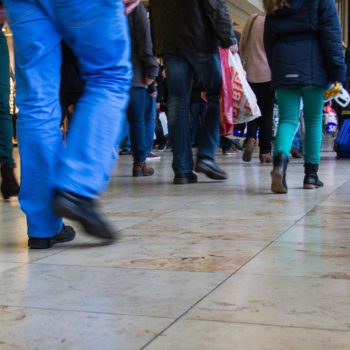How Marketers Should Be Leveraging Mobile to Drive Customers in Store
by Lindsay Rowntree on 31st May 2017 in News

Mobile browsing and online spending through smartphones and tablets has grown considerably in the past four years. Last year in the UK, online retail sales topped £133bn and research from VoucherCodes.co.uk has revealed mobile devices unlocked an enormous £200m sales in store last year alone. So, if this is the case, why is it many retail marketers struggle to leverage mobile browsing in order to drive footfall, asks Paul Lewis, senior director of marketing, VoucherCodes.co.uk, part of RetailMeNot.
A consumer study from Ipsos MediaCT and Sterling Brands back in 2014, involving research and consumer journals found that consumers valued local information as one of the key factors of the shopping journey – shoppers want to be able to find the information at their fingertips before shopping. This includes checking local prices, stock location, store location, alternative items and alternative stores through search engines, the store’s app, other retail apps, and coupon sites.
Evidently, this is an integral part of the consumer shopping journey and directly impacts the buying decision; therefore, marketers must now strive to keep this at the forefront of their policies in order to drive in-store spend.
What consumers want
Whilst online shopping via the traditional PC or laptop remains the preference, mobile retail is, in fact, the largest growth area in the sector, so there is a huge opportunity for brands to cement themselves in this gap. In France, for example, 53% of shoppers claim to use their mobile phones at least once when out shopping – known as ‘showrooming’ – and at least 5% have bought goods cheaper online that they saw in store as a result. This creates an enormous opportunity for marketers to tap into the way shoppers now use their mobile devices on-the-go.
Take a fashion brand, for example – shoppers are very likely to find inspiration online or from social media. Therefore, pairing social sites alongside the right information, advertisement, or digital coupon that is personalised to the shoppers local area, could direct shoppers into the store closest to them to purchase the item, which they then might additionally share on social.
In addition, by providing local information about what is in stock and where, marketers should be encouraging their brand to let shoppers reserve the goods before they even enter the store. This gives shoppers a feeling of ‘first look’ exclusivity, peace of mind, and encouragement to use the store to engage with staff, who can offer a great customer service.
Brands should also be ensuring that their product is positioned and priced fairly, if not cheaper, than competitor stock across other websites. Brands may sometimes find that when customers are browsing on a mobile in-store, this might prevent or slow down a purchase because the shopper may find that product reviews may be diverse, or a similar product is available more cheaply at another store or site.
Technology & tactics
Statistically, there are now more mobiles in the world than there are people – in fact, there are 124.5 mobile subscriptions for every one hundred people. As a result, marketers and retailers should be incorporating the technology at every opportunity in order to exploit the mass adoption and link the digital and physical in order to increase overall sales figures. Here are some simple, yet effective, ways marketers can introduce mobile to encourage shoppers in store:
Providing product information via beacons. If a brand already has an app, be it for shopping or just inspiration, it should always have a Bluetooth-enabled outreach setting. In London, Regent Street stores, including Hamleys, Armani, Longchamp, and Hackett, have their own app so that customers can walk through the stores receiving messages on deals or promotions to drive the path to purchase.
Proximity marketing. Offering a localised, wireless distribution of advertising content to shoppers in a certain area can unlock so much potential for marketers. Marketers will have to ensure their customers are signed up to the app, or agreed to receive texts or emails. However, the advantage for bricks and mortar retailers is that the shopper is actually near enough to be able to pop into the store without inconvenience.
Coupons, vouchers and micropayments. Encouraging quick pay in-store through an app for lower cost items, or promoting exclusive discounts, can add a new wave of capabilities to a customer’s shopping experience. This will encourage certain behaviours such as shopping off-peak, repeat purchases, and paying with mobile. Customers can also use these functions to redeem points like a loyalty card, or receive exclusive access to new launches or sales, ensuring footfall and loyalty in-store
As technology continues to revolutionise the way we research, shop, and interact with brands, the means of mobile to encourage shoppers’ in-store is also rapidly changing in ways that we cannot even predict. Shopping is no longer divided into the plain and simple ‘clicks vs bricks’ and the lines are increasingly blurred. However, there is a huge opportunity to be had by marketers to position themselves as an innovator and prove ROI for their brand.
Customers now expect to switch between the online and in-store shopping experiences seamlessly and mobile is the best way to plug that gap. Shoppers want to investigate competitor prices, check stock location, and read consumer reviews all whilst on their way or standing right there within the store.







Follow ExchangeWire